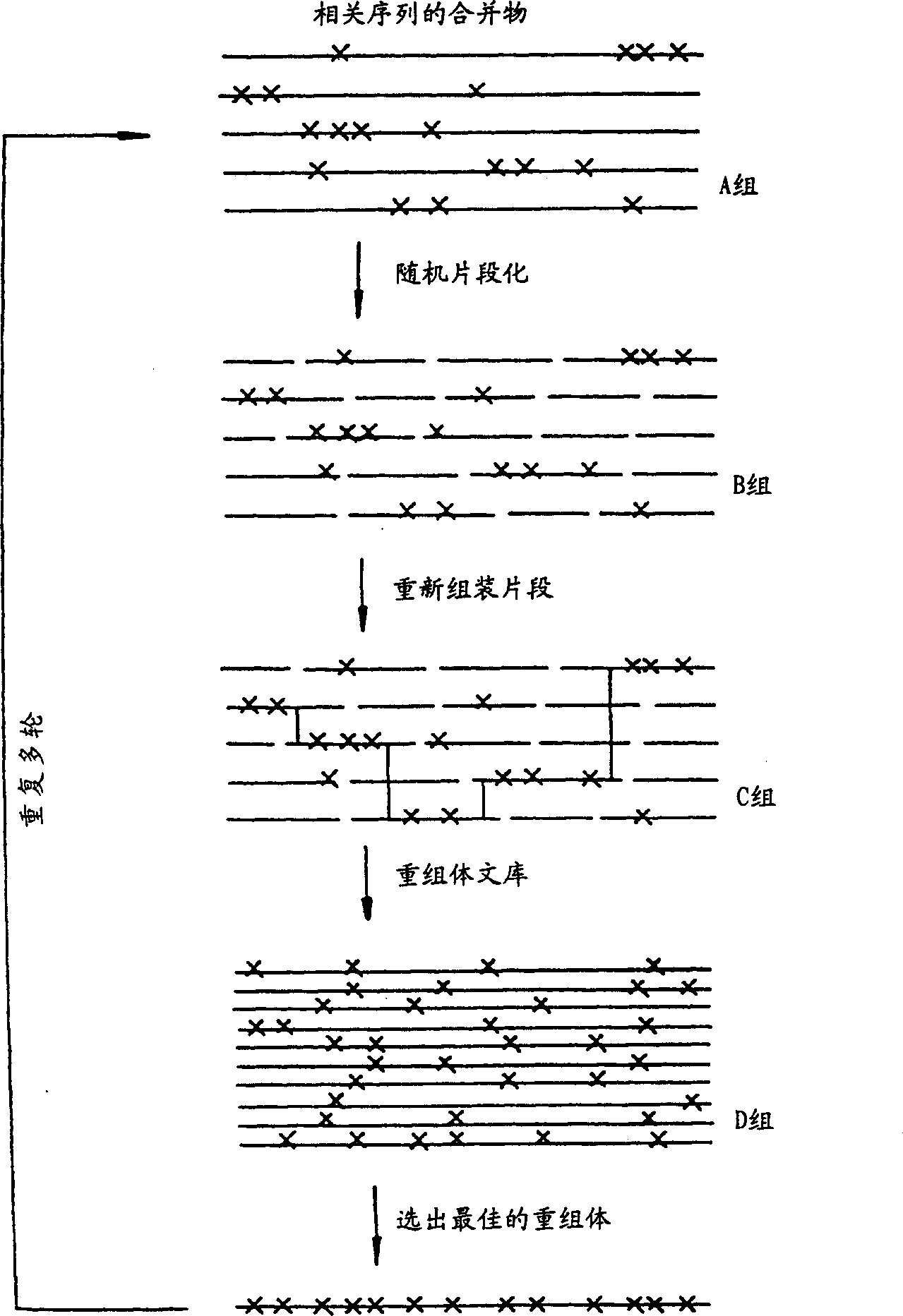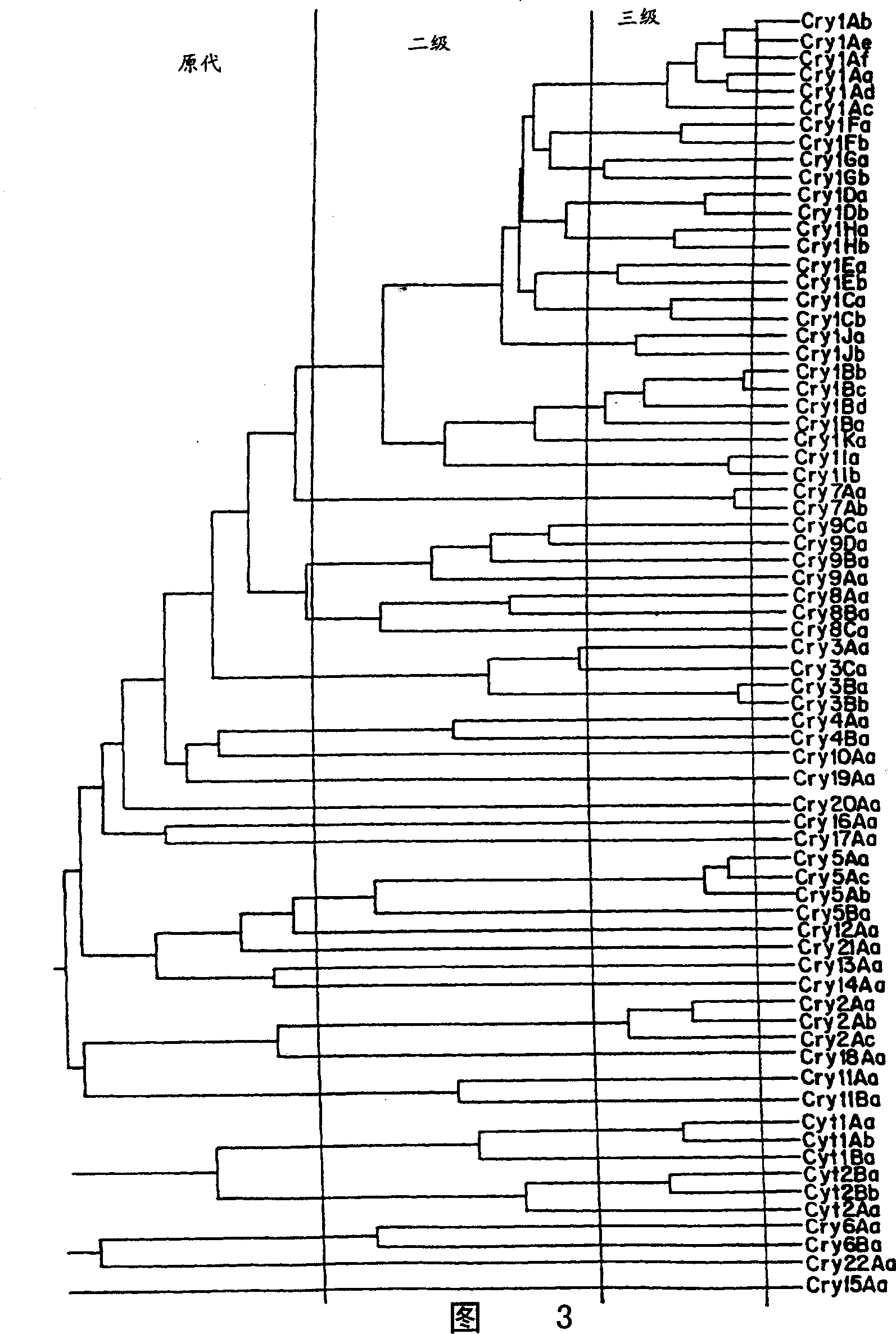Optimization of pest resistance genes using DNA shuffling
A technology for resistance genes and pests, applied in recombinant DNA technology, genetic engineering, organic chemistry, etc., can solve problems such as lack of activity
- Summary
- Abstract
- Description
- Claims
- Application Information
AI Technical Summary
Problems solved by technology
Method used
Image
Examples
Embodiment 1
[0268] Example 1: Optimization of CRYl toxin with DNA shuffling
[0269] The cry1C gene including its own promoter (5' region to -260 nucleotides) was used as a substrate for DNA shuffling. After DNA shuffling, the protein coding region was cloned into an expression vector and transformed into E. coli cells. The transformed cells were incubated in a bacterial culture medium (nutrient broth) at 30°C for 72 hours, and then the cells formed inclusion bodies composed of Cry1C protein. Then the cells are harvested by centrifugation or filtration, lysozyme is used to lyse, and free inclusion bodies are released. Alternatively, lysis can be achieved by detergent treatment, sonication, or other methods known to those skilled in the art. The inclusion bodies are collected by centrifugation or filtration, and then exposed to an alkaline solution (pH 10.5) with or without a disulfide bond reducing agent (such as 2-mercaptoethanol). Then trypsin is used to activate the Cry 1C protein dissolve...
Embodiment 2
[0272] Example 2: Reorganization of the insecticidal toxin gene of Bacillus japonicus
[0273]Bacillus japonicus is known to be a pathogen of scarab beetles (such as Japanese beetles), which produces an insecticidal protein called Cry18Aa (Zhang et al. (1997) J. Bacteriol. 179: 4336-4341). However, the insecticidal activity of the protein is not high enough to be used on a large scale to prevent crop damage caused by beetle infestation. This example describes the optimization of Cry18Aa by shuffling the cry18Aa gene of Bacillus japonicus and its Bacillus thuringiensis homologous gene cry2.
[0274] The cry18Aa gene was amplified by polymerase chain reaction (PCR) from Bacillus japonicus with two primers. The two primers were designed according to the published sequence (GenBank accession number: X99049). The forward primer (5'-gaaggaggctattggCCatgGac-3') is based on the ribosome binding site and the sequence surrounding the translation initiation signal. The sequence was modified ...
Embodiment 3
[0280] Example 3: Cloning of previously unknown genes from insect pathogens encoding insecticidal proteins
[0281] Genomic DNA is prepared from several insect pathogens, such as Pseudomonas aeruginosa and Serratia entomophilus. The DNA samples were digested with several enzymes including NotI, BamHI and SphI. The fragments produced by these enzymes are graded according to size, and cloned into a cosmid vector (such as Supercos (Stratagene)) or lambda vector (such as λZAP (Stratagene)) according to size. The tomato hornworm and cucumber beetle were then used to screen the E. coli library containing insect pathogen DNA for insecticidal activity. E. coli cells were cultured in LB broth at 30°C for 48 hours and harvested by centrifugation. The pelleted cells are resuspended in a minimum amount of water and placed on insect food. Allow insects to eat the food for 3 days. Several cosmid clones showing insecticidal activity were identified, and the DNA was isolated.
[0282] The cosmid ...
PUM
 Login to View More
Login to View More Abstract
Description
Claims
Application Information
 Login to View More
Login to View More - R&D
- Intellectual Property
- Life Sciences
- Materials
- Tech Scout
- Unparalleled Data Quality
- Higher Quality Content
- 60% Fewer Hallucinations
Browse by: Latest US Patents, China's latest patents, Technical Efficacy Thesaurus, Application Domain, Technology Topic, Popular Technical Reports.
© 2025 PatSnap. All rights reserved.Legal|Privacy policy|Modern Slavery Act Transparency Statement|Sitemap|About US| Contact US: help@patsnap.com



